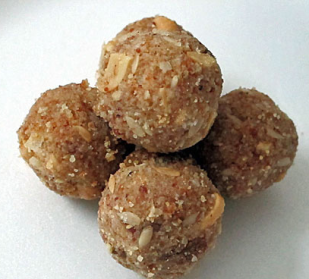Recently I got frequent enquiries from my patients and readers asking about the authentic recipe of traditional winter special nutritious laddus. Some wanted to confirm whether they are doing it rightly. Some didn’t know at all how to make them as they did eat in their childhood when their grandmother used to make but their mother didn’t frequently.
Some hated those laddus in childhood but now are concerned about the benefits of it and want to avail for themselves and their children. I answered some of them and promised to write on the same to some.
First of all the recipe of traditional winter laddus is so much in to the Indian tradition that any mother can explain better than me. Many of the readers will think what’s that great in the recipe, it’s so simple. But this blog is specially for those who wants to know the authentic recipe, want to know the exact benefit of it.
Moreover I am so happy that these ladies are taking interest in the right traditional recipe and are willing to invest some efforts in preparing despite of their very busy schedule and work commitments.
A little variation in every home is common depending upon the region and ingredients available in the specific area. A general recipe is put forward here. In some home it may vary a little but the central theme of the recipe is the same.

Traditional recipe: Winter nutritious laddus
Ingredients:
- Roughly ground wheat with fiber flour: 500gm bowl
- Roughly ground ragi with fiber: 500gmbowl
- Dry roasted and roughly powered Almonds, ,Dried Dates, Cashews, Walnuts) :250gm of all mixed
- Grated and roasted coconut 100gm
- Blackcurrents whole 50gms
- Fenugreek seeds soaked in pure cow ghee for overnight and then finely ground in to paste: 50gm
- Edible resin (gond in hindi / Dink in Marathi)deep fried in pure cow ghee and roughly broken in to small pieces 50gm(do not make powder as the small pieces of crispy resins (Gond /Dink)while eating the laddu add the tasty surprise element to the recipe)
- Marking Nut seeds Kernel which is known as Bhilava magaj in hindi and Bibba Godambi in Marathi 25gm
- Nutmeg and cardamom powder 2tsp.for its exotic aroma.
- Organic soft jaggery approximately 700gm or as per the sweetness required. Its always better to avoid white sugar.
(Being an Ayurveda follower I will advise to add 5tsp dry ginger(sonth or sunth) powder and 50gms of Shatavari (Asparagus ) root powder in the mixture)
Procedure:
- Roast the wheat flour and ragi flour separately in a pan using cow ghee till it turn golden brown with a pleasant roasting aroma.
- Add the above mentioned powders into the flour and mix well.
- Mix the finely grated or powdered jaggary when the mixture is settling at the room temperature.Do not mix the jaggery when the mixture is very hot as the jaggery will melt and turn hard on cooling down while making the laddus .
- Mix well and use cow ghee as per the requirement . Ensure the mixture has enough ghee to allow us to make superfine shiny soft balls or laddus.
- Roll the laddus or just keep the mixture as it is and eat with spoon.
- Given measurements make the 30 to 40 laddus.
- Store them in air tight clean and dry container or jar. Avoid storing in the plastic jar.
- Eat them before one month .
- 1 laddu in the morning time with a cup of warm milk will be the good start and healthy step towards the day.
- Those having good appetite can have 2 laddus in a day
- People having Pitta dominance body type (prakriti) avoid more than two laddus in a day .
- Eating it after meal is not a good idea as the ingredients are heavy to digest .
This is all about the highly nutritious winter laddus for all .let me know your experience of making it and also if any queries feel free to ask.
Keep reading , Keep healthy !
(The above write up belongs to Dr. Rupali Panse. You can generously share the blog with the author name.)



Very informative post.. wo purane din yad aa gaye…
LikeLiked by 1 person
nice recipe.even adding saffron and peprimool powder(reduces colestrol) will give added benifit
LikeLiked by 1 person
Why godambi is used?
Health benefits of it?
When to avoid eating godambi?
Bit scared to use as it is a seed of biba n it is very hot in nature.
LikeLike